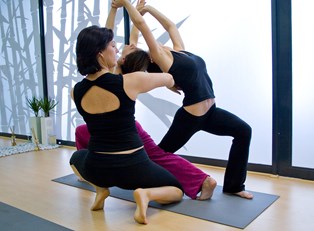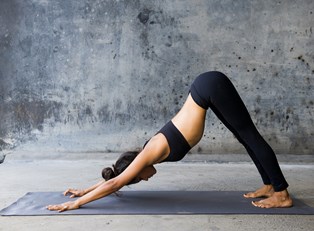One of the draws of yoga is the excitement of being able to twist yourself into new and crazy contortionist-like positions. And someday you’ll get there. But flexibility isn’t something you’re born with—you have to earn it. Unfortunately, the poses that look the most exciting to try are usually the most dangerous. If you take yoga classes but like a few sessions on your own time between visits, wait until you’re with an instructor to try and take anything you feel even remotely uncomfortable trying on your own.
Most importantly, don’t skip ahead. Yoga is a building exercise. Although some poses seem mundane and you might not see their purpose right off the bat, eventually you’ll be able to call what you’ve learned into action, ready to face poses that require serious strength, stamina, and balance. Although you can push your body too far in many poses, it can happen especially quickly with some of the advanced work. If you’re just starting out, here are six poses you almost certainly are not ready for yet.
Shoulderstand (Salamba Sarvangasana)
This pose requires lying on the floor, starting with your legs and rolling your body backward up off the floor until all the balance rests solely on the shoulders and neck. Initially, the arms provide stability by pushing against the floor or the small of the back. Pushing too hard can cause back as well as neck problems, and a twist the wrong way can do some serious damage to the neck. Perfect alignment is seldom achieved at a beginning level, and it is absolutely crucial to this pose.
Crane Pose (Bakasana)
Essentially, you put all your weight onto your arms, palms flat on the floor, and then rest your knees on your elbows while looking straight ahead. Why so dangerous? Crane pose requires serious balance and strength, and as many who have tried it can attest, you’re going to fall over repeatedly before you get it right. Unfortunately, if you don’t have the needed arm strength to keep yourself elevated, you can fall onto your arms, sprain a wrist, or overbalance, topple forward, and smash your face.
Pigeon Pose (Eka Pada Rajakapotasana)
The modified version of this is fine for beginners. To start out, one leg goes in front of the body, with the foot pulled back toward the abdomen, but still on the floor. The other leg remains stretched out behind you, and hands are on the floor a little more than shoulder width apart.
For a deeper stretch, one arm reaches over the head, while the other reaches up from behind until the fingers touch, and then the back leg is bent at the knee until the toes are trying to touch the bottom elbow. At this point, the hip is stretched very deeply, and the weight tends to be pushing through the pelvis toward the floor. Lots of hips simply aren’t ready for this, which can cause considerable pain, pulled muscles, and hip displacement. When the hips aren’t prepared to stretch this deeply, it can also pull too much on the knee joint, causing additional problems.
Plow Pose (Halasana)
While lying flat on the floor, the legs bend at the hips, and come forward over the head so that the toes reach for the floor past the crown of the head. The stability and straightness of the back are crucial, and if muscles aren’t strong enough, you can definitely pull one the wrong way. Additionally, too much pressure can be put on the neck, causing painful compression.
Little Thunderbolt Pose (Laghu Vajrasana)
While sitting on your knees, you drop from the head backward toward the floor, entering into a backbend. Deep backbends can go wrong quickly. Particularly, in this one the pelvis and thighs have to stay pressed forward to maintain balance. If the legs aren’t strong enough to maintain the position, losing your balance can send you careening backward, shoving your head, and therefore neck, straight into the ground. The real trick, however, is getting back out of it properly without pulling a muscle.
Scorpion Pose (Vrschikasana)
Hypothetically, you’re supposed to go into a forearm stand and then bring your legs backward toward the crown of your head, bending your body slightly, but maintaining balance with the arms and back. For extra points, touch your toes to your head. Anything involving a hand stand of any sort, is highly advised against, and one that involves a back bend in tandem can go wrong in just about every way imaginable.



